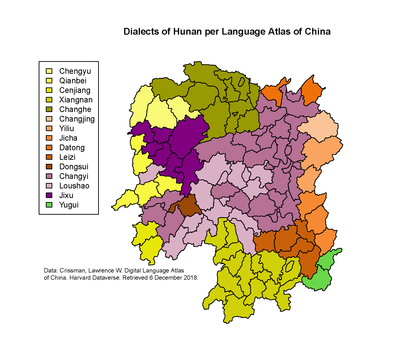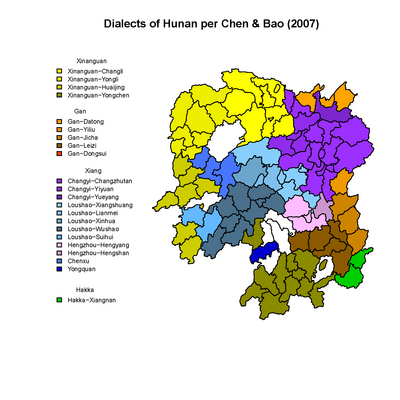Xiangxiang dialect
| Xiangxiang dialect | |
|---|---|
| 湘乡话 | |
| Native to | China |
| Region | Xiangxiang, Hunan province |
| Language codes | |
| ISO 639-3 | – |
Xiangxiang dialect (Chinese: 湘乡话; pinyin: Xiāngxiāng huà) is a dialect of Xiang Chinese, spoken in Xiangxiang, Hunan province, China. It is part of a group of dialects called the Central Xiang dialects[1].
Geographic Distribution
The linguistic maps below are derived from the Digital Language Atlas of China[2], which is derived from the Language Atlas of China[3], the first atlas to comprehensively catalog and chart the distribution of Chinese dialects[4]. This atlas refers to the two main dialects in Xiangxiang City and its surroundings as Changyi (长益片 / 長益片) and Loushao (娄邵片 / 婁邵片).
The division of Xiang into New Xiang and Old Xiang was introduced by Yuan Jiahua[5], but has been superseded by the Language Atlas of China classifications[6].
| Dialect map of Hunan Province according to the Language Atlas of China[2] |
|---|
The Language Atlas of China serves as the starting point for many efforts to further detail, map and classify Xiang dialects, including the many studies of Bao Houxing and Chen Hui[7][8].
| Dialect map of Hunan Province according to Chen and Bao (2007)[9] |
|---|
| Linguistic map of Xianxiang City and surrounding counties[3] |
|---|
| Sample Locations of Xiangxiang Dialect Studies[1][3][10][11] |
|---|
History and Strategic Value
The Xiang dialect group forms a transitional zone between northern and southern Chinese dialects[5].
Prehistorically, the main inhabitants were Ba_(state), Nanman, Baiyue and other tribes whose languages cannot be studied. During the Warring States Period, large numbers of Chu migrated into Hunan. Their language blended with that of the original natives to produce a new dialect Nanchu (Southern Chu). The culture of Xiangxiang at the center of Hunan is considered to be mainly Chu. The language of Shaoshan, Loudi, Shuangfeng and Xiangxiang (Old Xiangxiang) is considered as originating from a synthesis of Chu and the languages of original natives. [12]
Migrations into Hunan can be divided into three periods. Before the Five Dynasties and Ten Kingdoms period, migrants came mainly from the North. Between the Five Dynasties and Ten Kingdoms period and the Ming dynasty, migrants came mainly from Jiangxi. After the middle of the Ming dynasty, migration gradually became more diverse. Migrants who came from the North mainly in northern Hunan followed by western Hunan. For this reason northern and western Hunan are Mandarin districts. Migrants from Jiangxi concentrated mainly in southeastern Hunan and present day Shaoyang and Xinhua districts. They came for two reasons' The first is that Jiangxi became too crowded and its people sought expansion. The second is that Hunan suffered greatly during the Mongol conquest of the Song dynasty, when there was mass slaughter[1], and needed to replenish its population. In the early Ming dynasty, large numbers of migrants came from Jiangxiand settled in present day Yueyang, Changsha, Zhuzhou, Xiangtan, and Hengyang districts. After the middle of the Ming dynasty, migrants came more diverse, and came more for economic and commerce.[12]
Phonology
Comparison with Standard Chinese
| Feature | Standard Chinese | Xiangxiang Locations | Ninxiang Location | ||||
|---|---|---|---|---|---|---|---|
| Dictionary[13] | Chao[14] | Chengguan[1] | Yueshan[11] | Jinsou[10] | Baitian[10] | Huitang[10] | |
| Consonants and Initials |
21 | 23 | 29 | 28 | 24 | 26 | 24 |
| Vowels and Finals |
35 | 37 | 37 | 38 | 42 | 37 | 38 |
| Tones | 4 | 4 | 7 | 5 | 6 | 6 | 6 |
General
These phonetic charts use IPA phonetic symbols with the addition of curly-tail alveolo-palatal symbols[15] and follow the format set forth by Chao[14].
Consonants
| bilabial | alveolar | denti-alveolar | alveolo-palatal | retroflex | velar | ||
|---|---|---|---|---|---|---|---|
| nasal | m | n | ȵ | ŋ | |||
| plosives | voiced | b | d | ɡ | |||
| voiceless unaspirated | p | t | k | ||||
| voiceless aspirated | pʰ | tʰ | kʰ | ||||
| fricatives | voiced | ɣ | |||||
| voiceless | s | ɕ | ʂ | x | |||
| affricates | voiced | dz | dʑ | dʐ | |||
| voiceless unaspirated | ts | tɕ | tʂ | ||||
| voiceless aspirated | tsʰ | tɕʰ | tʂʰ | ||||
| lateral approximants | l | ||||||
Tones
Phonemically, Xiangxiang dialect has seven tones[1].
| Tone number | Tone name | Tone contour | Description |
|---|---|---|---|
| 1 | yin ping (陰平) | ˥ (55) | high |
| 2 | yang ping (陽平) | ˩˧ (13) | extra low rising |
| 2' | ci yang ping (次陽平) | ˨˧ (23) | low rising |
| 3 | shang sheng (上聲) | ˨˩ (21) | low |
| 5 | yin qu (陰去) | ˦˥ (45) | high rising |
| 5' | ci yin qu (次陰去) | ˧˥ (35) | high rising |
| 6 | yang qu (陽去) | ˧ (33) | mid |
Jinsou Town[10]
Consonants
| bilabial | alveolar | denti-alveolar | alveolo-palatal | retroflex | velar | Laryngeal | ||
|---|---|---|---|---|---|---|---|---|
| nasal | m | n | ȵ | ŋ | ||||
| plosives | voiced | b | d | ɡ | ||||
| voiceless unaspirated | p | t | k | [[:en:Zero (linguistics)|Ø]] 油 | ||||
| voiceless aspirated | pʰ | tʰ | kʰ | |||||
| fricatives | voiced | ɣ | ||||||
| voiceless | s | ɕ | ʂ | x | ||||
| affricates | voiced | dz | dʑ | dʐ | ||||
| voiceless unaspirated | ts | tɕ | tʂ | |||||
| voiceless aspirated | tsʰ | tɕʰ | tʂʰ | |||||
| lateral approximants | l | |||||||
Yueshan Town
Tones
| Tone number | Tone name | Tone contour | Description |
|---|---|---|---|
| 1 | yin ping (陰平) | ˥ (55) | high |
| 2 | yang ping (陽平) | ˩˧ (13) | low rising |
| 3 | shang sheng (上聲) | ˨˩ (21) | low |
| 4 | yin qu (陰去) | ˦˥ (45) | high rising |
| 5 | yang qu (陽去) | ˨ (22) | mid |
See also
References
- ^ a b c d e f Coblin, W. South (2011). Comparative Phonology of the Central Xiāng Dialects. Taipei, Taiwan: Institute of Linguistics, Academia Sinica. ISBN 978-986-02-9803-1.
- ^ a b Crissman, Lawrence W. "Digital Language Atlas of China". Harvard Dataverse. Retrieved 6 December 2018.
- ^ a b c Lavely, William; Berman, Lex. "Language Atlas of China". Language Atlas of China. Harvard Dataverse. Retrieved 2 December 2018.
- ^ Cao, Zhiyun; Liu, Xiaohai (14 December 2012). "The Introduction of Linguistic Atlas of Chinese Dialects". Papers from the First International Conference on Asian Geolinguistics: 141–151. Retrieved 7 December 2018.
- ^ a b Wu, Yunji (2011). A Synchronic and Diachronic Study of the Grammar of the Chinese Xiang Dialects. De Gruyter Mouton. Retrieved 7 December 2018.
- ^ Kurpaska, Maria (2010). Chinese Languages: A Look Through the Prism of the Great Dictionary of Modern Chinese Dialects (Trends in Linguistics. Studies and Monographs). De Gruyter Mouton. ISBN 9783110219142. Retrieved 7 December 2018.
- ^ Bao, Houxing; Chen, Hui (24 August 2005). "Xiangyu de Fenqu". Fangyan. 2005 (3): 261–270.
- ^ Li, Kang-cheng (July 2014). "Comparative Study Reviews of Chinese Dialects in Hunan in Recent Thirty Years". Journal of Hunan University of Science & Technology (Social Science Edition). 17 (4): 136–143. Retrieved 7 December 2018.
- ^ Chen, Hui; Bao, Houxing (March 2007). "Hunansheng de Hanyu Fangyan (Manuscript)". Fangyan: 250–259. Retrieved 10 December 2018.
- ^ a b c d e 文, 丹 (2004). 湖南宁乡与湘乡边界东段的方言状况. Changsha, China: Hunan Normal University. Retrieved 27 November 2018.
- ^ a b c Nakajima, Motoki (1990). Report on Xiang Dialects part 2. Tokyo: Tokyo University of Foreign Studies, Research Institute for Languages and Cultures of Asia and Africa. ISBN 4-87297-025-X. Retrieved 21 November 2018.
- ^ a b Jiang, Junfeng (June 2006). A Phonological Study of Xiangxiang Dialect (PhD). Hunan Normal University. Retrieved 6 December 2018.
- ^ Xiandai Hanyu Cidian (6 ed.). Beijing: The Commercial Press. 2015. ISBN 978-7100084673.
- ^ a b Chao, Yuen Ren (1968). A Grammar of Spoken Chinese. Berkeley: University of California Press. ISBN 0520002199.
- ^ Cook, Richard S. "On the status of the curly-tail alveolo-palatal (舌面前)symbols" (PDF). STEDT. Department of Linguistics at the University of California, Berkeley. Retrieved 3 December 2018.
Bibliography
- 湖南省地方志编纂委员会编 (2001). 湖南省志,第二十五卷,方言志,上册. 长沙: 湖南人民出版社.
{{cite book}}: Invalid|ref=harv(help) - Li, Jialong (李加龙) (2017). Hànyǔ Fāngyán Diàochá 汉语方言调查. Beijing: The Commercial Press. ISBN 978-7-100-12869-8.
{{cite book}}: Invalid|ref=harv(help) - "湖南方言中它最难懂 被称为"湖南的外国话"". 潇湘晨报. 3 April 2017. Retrieved 11 January 2019.
{{cite news}}: Invalid|ref=harv(help)





